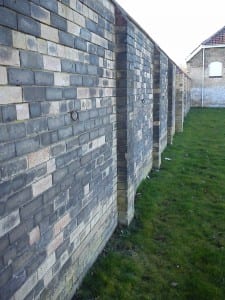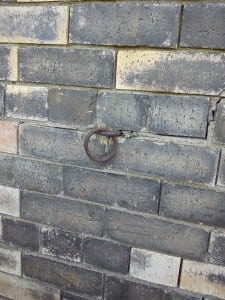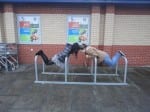The wall that remains outside, next to the Weighing Room, is set to be a prominent aspect of the performance. The Women of War group have since developed the ‘Suppression versus Liberation’ idea, and the wall is now likely to mark the end of our piece. Rather than the wall and chains representing women’s societal position pre-war, the location will be strongly visual, hanging objects that symbolise key aspects of the whole performance. For example, the group that are particularly interested in horse racing and betting, their object may be a horse shoe. The Women of War group are planning to hang a china tea cup, to symbolise the domestic role of women, and the community essence of the site that still remains today.

After more group discussion, the installation is possibly going to be developed further, with audience members taking part in the hanging of the objects. The effect of audience participation highlights the importance of the Grandstand as a landmark for the community of the city, and suggests a sense of ‘ritual’ or ‘memorial’. The wall will subsequently remain as a commemoration of the performance, being fixed, as opposed to the performance itself, which will be unique and cannot be the same again. The wall installation idea is inspired by the Pont de l’Archevêché, a bridge in Paris that is covered in padlocks left by lovers. The intriguing display is an example of evoking repercussions, emotion and brings life to the site itself. The tree structures on Luzhkov Bridge in Moscow also display padlocks; each representing the strength of a relationship. These random spectacles created purely by human intuition demonstrates “the transforming of the everyday into the extraordinary, the finding of poetry in something so mundane as a padlock” ((Daily Mail (2012) The Lock of Love, Online: http://www.dailymail.co.uk/femail/article-2172901/The-lock-love-For-years-couples-world-left-padlocks-bridges-tokens-love-Now-Britons-unlocking-inner-passions-too.html (accessed 21 March 2013).)). The objects that we choose to hang may also be seemingly unexciting, yet their presence on the wall brings about a new meaning, and equally emphasises the importance of the wall.
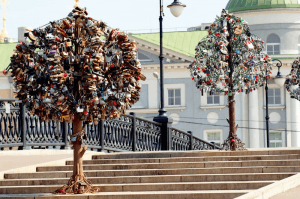
The padlock displays are similar to the recurrence of hanging shoes or trainers, sometimes known as ‘shoefiti’. The mysterious appearance of shoes, commonly on power lines, is an event that occurs anonymously, and is then discovered as a piece of contemporary, urban art. Credibility as art is questionable for many, but the shoes are thought to resemble “the number of runners” ((Gabrielle Giroday (2011) Running down theories about hanging shoes, Online: http://www.brandonsun.com/breaking-news/running-down-theories-about-hanging-shoes-118826304.html (accessed 21 March 2013).)) that pass down a street in some areas of Europe. The shoes have a ghostly effect, in the way that they resemble someone that has once been there to hang them, and the site can then conjure up questions and discussion by onlookers.
Sage Vaughn, a fine artist from Los Angeles, has recently collaborated with Converse to create a piece of public art for the SXSW Festival in Texas.The Monument 1 installation consisted of a metal structure with hanging Converse trainers. The company have also created pop-up stores in Paris, with similar decorative hangings of shoes, as a method of demonstrating their creativity.
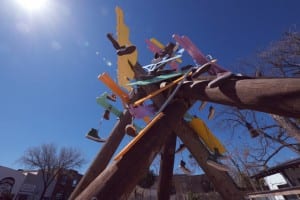
The above examples demonstrate the connection between visual art and site that has also been discussed by Kastner and Wallis, in their typology of land art (2008):
Integration: the manipulation of the material landscape in its own right, the artist adding, removing or displacing materials – marking, cutting, rearranging – to create sculpture, drawing out the relationships between existing characteristics of site and evidence of human intervention. This is often monumental in scale, as in Robert Smithson’s large-scale construction Spiral Jetty (1970) ((Pearson, Mike (2010) Site-Specific Performance, Basingstoke: Palgrave Macmillan.)).
Thus, our performance at the Grandstand with the inclusion of symbolic visual installations can communicate the relationship that the group has established with the site, and emphasising the connection of the site and the city itself. The objects on the wall will also indicate the historical context of the site, both past and present, and as a result will bring about a positive future for the Grandstand.
